NCERT Class 10 Science Chapter 10 The Human Eye and The Colourful World Notes Solution For School Students of Class 10th. We also Provides Notes and Important Questions for Class 10 Science. NCERT Class 10th Science book is applied in mostly boards like CBSE, HBSE, RBSE, Up Board, MP Board and also some other state boards.
- Also Read:- Class 10 Science NCERT Solution
- Also Read – Class 10 Important Questions
NCERT Class 10 Science Chapter 10 The Human Eye and The Colourful World Notes for CBSE, HBSE, RBSE, UK Board, HP Board, MP Board and Other Boards Solution.
The Human Eye and The Colourful World Class 10 Science Chapter 10 Notes
Human Eye
The human eye is one of the most valuable organs as it enables us to see the beautiful, colourful world around us.
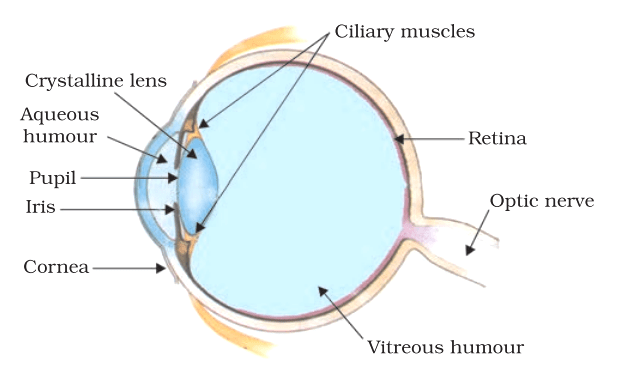
Human eye is like a camera.
Formation of image : Image is formed on a light sensitive screen called retina. The eye lens forms an inverted real image.
The eyeball is approximately spherical in shape with diameter of about 2.3 cm.
Iris : It is behind the cornea. It is a dark muscular diaphragm that controls the size of pupil.
Pupil : It regulates and controls the amount of light entering the eye.
Retina : The retina is a delicate membrane having enormous number of light-sensitive cells.
The light sensitive cells get activated and generate electrical signals. These signals are sent to brain via optic nerves. The brain interprets these signals, and finally processes the information.
Power of Accommodation
The ability of the eye to focus on both near and distant objects, by adjusting its focal length, is called the accommodation of the eye.
The smallest distance, at which the eye can see objects clearly without strain, is called the near point of the eye or the least distance of distinct vision. For a young adult with normal vision, it is about 25 cm.
Cataract : Sometimes, the crystalline lens of people at old age becomes milky and cloudy. This condition is called cataract.
Defects of vision and their correction
The common refractive defects of vision include myopia, hypermetropia and presbyopia.
- Myopia : It is also known as near-sightedness. A person with myopia can see nearby objects clearly but cannot see distant objects distinctly. In myopic eye, the image of a distant object is formed in front of the retina.
Causes : (i) excessive curvature of the eye lens,
(ii) elongation of the eyeball.
Correction : This defect can be corrected by using a concave lens of suitable power. A concave lens of suitable power will bring the image back on to the retina.
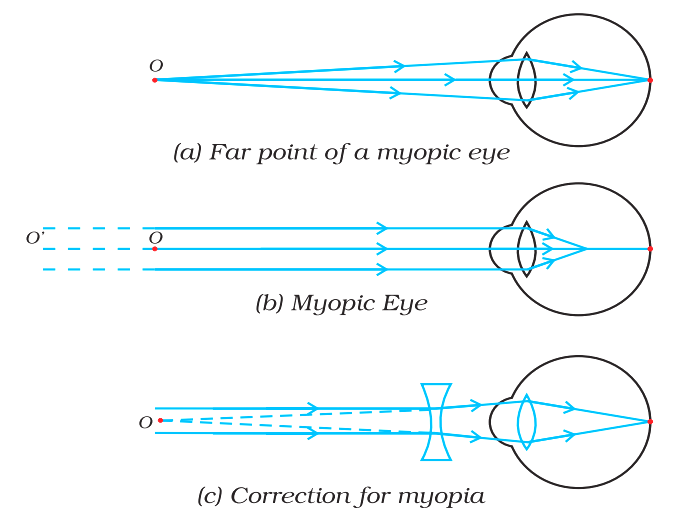
- Hypermetropia : It is also known as far-sightedness. A person with hypermetropia can see distant objects clearly but cannot see nearby objects distinctly. In hypermetropic eye, the image of object is formed behind the retina.
Causes : (i) The focal length of the eye lens is too long,
(ii) the eyeball has become too small.
Correction : This defect can be corrected by using a convex lens. Eye-glasses with converging lens provide the additional focussing power required for forming the image on the retina.
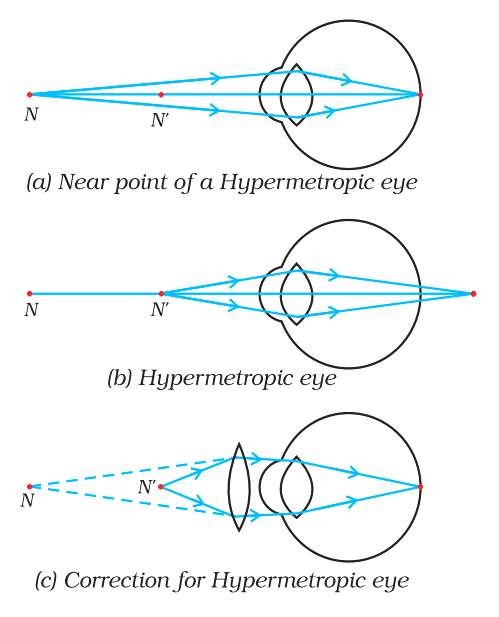
- Presbyopia : The power of accommodation of the eye usually decreases with ageing. Old people find its difficult to see nearby objects comfortably and distinctly without corrective eye-glasses. This defect is called presbyopia.
Causes : It arises due to the gradual weakening of the ciliary muscles and diminishing flexibility of they eye lens.
Correction : Bifocal lens is used to correct presbyopia. A common type of bi-focal lens consists upper portion of concave lens and lower part using convex lens.
Dispersion of white light by a Glass Prism
The splitting of white light into its component colours is called dispersion.
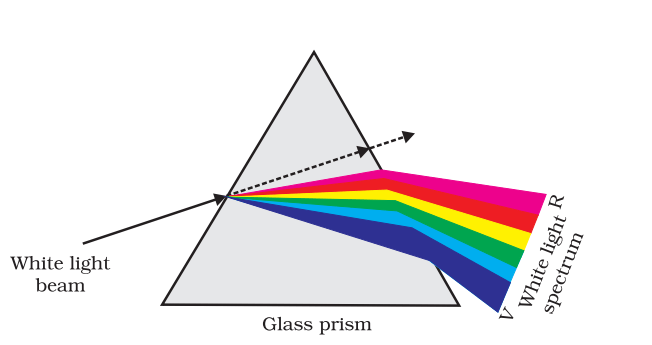
Sequence of colour we see on the screen : Violet, Indigo, Blue, Green, Yellow, Orange and Red. (VIBGYOR)
Rainbow : A rainbow is a natural spectrum appearing in the sky after a rain shower. It is caused by the dispersion of sunlight by tiny water droplets, present in atmosphere. A rainbow is always formed in a direction opposite to that of the Sun. They refract and disperse the incident sunlight, then reflect it internally, and finally refract it again when it comes out of the raindrop.
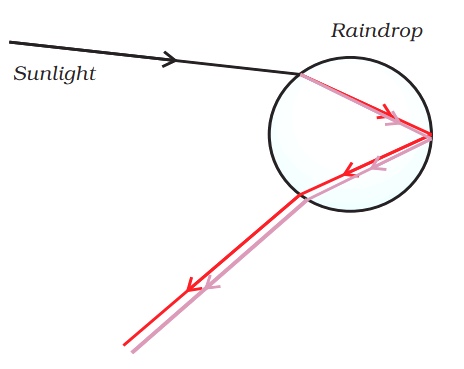
Atmospheric Refraction
The refraction of light induced by the earth’s atmosphere is known as atmospheric refraction. This happens due to different layers of the earth’s atmosphere vary in terms of optical densities.
Phenomenon related to atmospheric refraction :
- Twinkling of stars : The twinkling of a star is due to atmospheric refraction of starlight. As the stars are very far away, they behave as almost a point source of light. When the light coming from stars enters the earth’s atmosphere, it gets refracted at different levels because of the variation in the air density. The path of rays of light coming from the star goes on varying slightly, the apparent position of the star fluctuates and the amount of starlight entering the eye flickers. So, sometimes, the star appears brighter and at some other time, fainter. Thus, the stars twinkle.
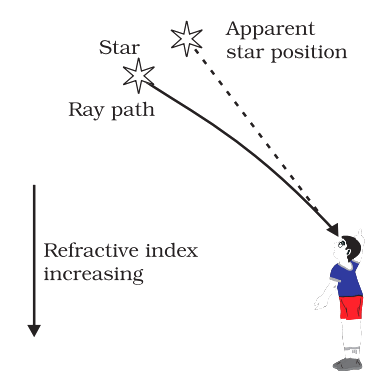
- Advance sunrise and delayed sunset : The sun is visible to us about 2 minutes before the actual sunrise and about 2 minutes after the actual sunset, because of atmospheric refraction.
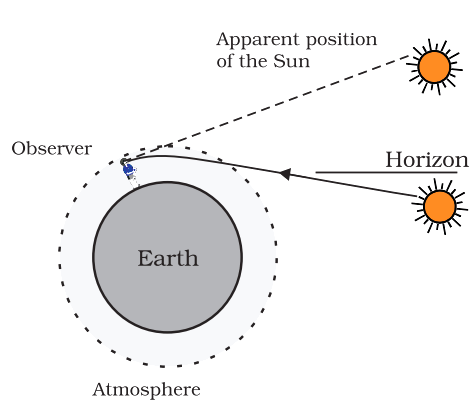
Scattering of Light
It is defined as the phenomenon in which light rays deviate from their path when it strikes with molecules of gas or dust, water vapors etc.
Phenomenon related to Scattering of light are as :
- Tyndall effect : The phenomenon of scattering of light by colloidal particles gives rise to tyndall effect. This phenomenon is seen when a fine beam of sunlight enters a smoke-filled room through a small hole. Thus, scattering of light makes the particles visible.
- Blue colour of sky : When sunlight passes through the atmosphere, the fine particles in air scatter the blue colour (shorter wavelengths) more strongly than red. The scattered blue light enters our eyes.
- Reddish colour of Sun at sunrise and Sunset
Other important :
- A person can donate his eyes after death. Eyes must be removed within 4-6 hours after death.
- Angle of prism : The angle between two lateral faces of prism is called angle of prism.
- Planets don’t twinkle.
- The colour of the scattered light depends on the size of scattering particles.
- The sky appears dark to passengers flying at very high altitudes.
- Danger signals are red in colour because red is least scattered by fog or smoke.